
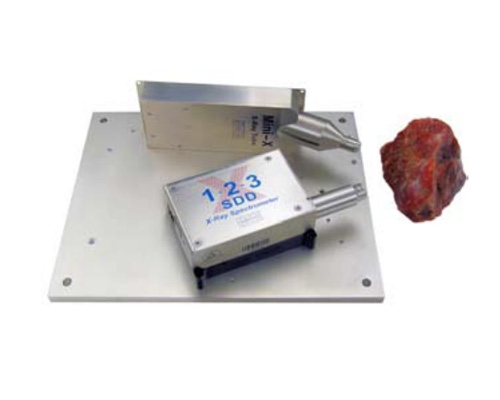
| FEATURES | APPLICATIONS |
| ? Fundamental parameters (FP) | ? X-Ray Fluorescence |
| ? Analysis with or without standards | ? Thin-film Analysis |
| ? General bulk and thin-film analysis | ? RoHS/WEEE Analysis |
| ? Analyze up to 40 elements | ? Teaching and Research |
| ? Supports all Amptek detectors (Si-PIN, Super SDD, CdTe), X-ray tubes, and electronics | ? Art and Archaeology |
| ? Auto-mode for continuous or repeated analysis | ? Process Control |
| ? CdTe escape peak correction | ? X-ray Tube Characterization |
| ? Non-destructive analysis | |
| | |

| | NIST VALUE | XRS-FP VALUE | |
| Steel316 | CR | 18.450 ± 0.05 | 18.500 ± 0.25 |
| Mn | 1.630 ± 0.01 | 1.670 ± 0.07 | |
| Fe | 65.190 ± 0.07 | 65.000 ± 0.52 | |
| Ni | 12.180 ± 0.05 | 12.270 ± 0.27 | |
| Cu | 0.169 ± 0.001 | 0.167 ± 0.026 | |
| Mo | 2.380 ± 0.01 | 2.390 ± 0.03 | |
| Steel321 | Cr | 17.400 ± 0.10 | 17.590 ± 0.23 |
| Mn | 1.800 ± 0.05 | 1.800 ± 0.07 | |
| Fe | 69.310 ± 0.15 | 68.910 ± 0.53 | |
| Ni | 11.200 ± 0.10 | 11.420 ± 0.27 | |
| Cu | 0.121 ± 0.001 | 0.119 ± 0.022 | |
| Mo | 0.165 ± 0.005 | 0.167 ± 0.009 | |

experiment conditions and to optimize processing.
XRF-FP Features
? Includes both an interactive “expert mode” and a “routine mode”. In expert mode, the user can see each step in the analysis and adjust parameters. In routine mode, after the spectrometer is set up and calibrated, one need only click a single button to acquire the data, process the spectrum, analyze the intensities, and save the output report.
handle multilayer samples up to 6 layers for simultaneous film thickness and composition analysis using FP with standards (please contact Amptek).
Second, one can choose FP with scatter ratios. This option is recommended when the sample contains a significant amount of low-Z materials, such as plastic. An estimate is made for the unanalyzed fraction of the sample by comparing the known fraction of analytes with the measured C/R ratio and ascribing the remainder to a pair of elements that bracket the estimated mean atomic number.
Several types of analysis cannot be standardless, i.e. calibration with standards (reference materials) is required.Least squares analysis cannot be standardless. If the mass thickness of the sample (i.e., the mg/cm2) is calculated, the analysis cannot be standardless.
Excitation Sources
Amptek supplies all parameters for its Mini-X X-ray tube and filter kit. If a tube from a different vendor is used, then the customer must find the critical parameters.
Radioisotopes can be used using a source file describing the relative line ratios. For secondary target excitation,monochromatic excitation is assumed.

Figure 3: Geometry angle definitions.

| XRF-FP Parameter | Value |
| Incidence Angle | 67.5° |
| Take-Off Angle | 67.5° |
| Alpha Angle | 0° |
| Scatter Angle | 135° |
| Tube-to-sample | 339 mm |
| Sample-to-detector | 159 mm |
Includes full corrections for absorption and both thick and thin-film secondary fluorescence. All possible lines are considered for both excitation and fluorescence. The analysis can be performed for all elements from H through Fm, using K, L or M lines in the energy range from 0.1 keV up to 60 keV.
Using known peaks in the spectrum, the software calculates the effective gain (eV/channel) and offset (zero shift) for the spectrometer. These factors are applied to subsequent spectra prior to other spectrum processing. The calibration can be specified in the XRF-FP software or in the ADMCA software. XRF-FP can automatically import the calibration from ADMCA.
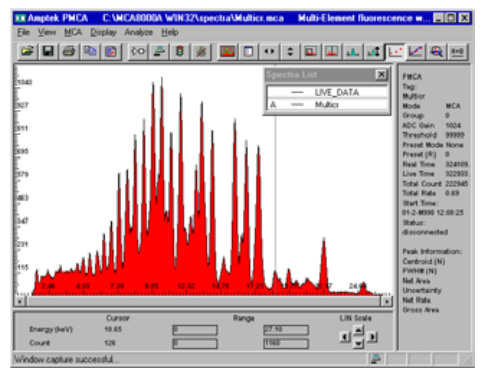 | 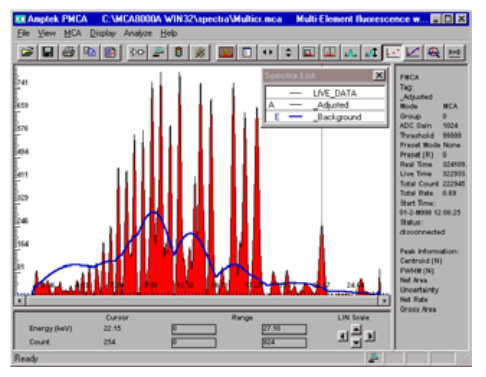 |
| Figure 5: Original spectrum before background removal. | Figure 6. Processed spectrum and background. The blue curve is the removed background. |
Escape Peak and Sum Peak Removal

All required line energies and resolutions are calculated automatically from the specified analyte line. The Gaussian peak fitting can be done with a linear or non-linear leastsquares approach. The latter allows constrained changes in the peak positions, intra-series line ratios, and peak widths,from their nominal starting points.
In addition to calculating elemental intensities, the software automatically calculates the estimated uncertainty and background values, which allows uncertainty and Minimum Detection Limit (MDL) calculations to be performed during the FP analysis.


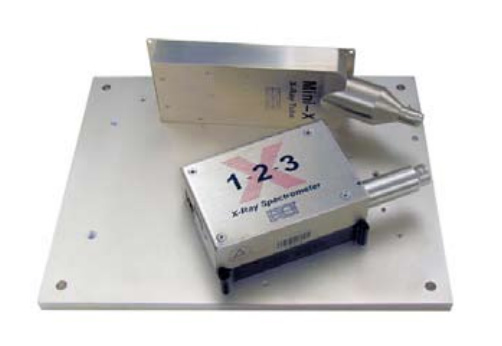 | 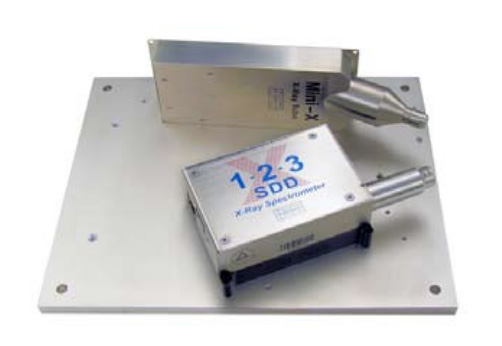 |
| Experimenter’s XRF Kit with Si-PIN Includes: | Experimenter’s XRF Kit with SDD Includes: |
| ? X-123 Complete Spectrometer with Si-PIN Detector (6 mm2/500 μm, 1 mil Be window) | ? X-123 Complete Spectrometer with Super SDD (25 mm2/500 μm, 0.5 mil Be window) |
| ? Mini-X USB Controlled X-Ray Tube | ? Mini-X USB Controlled X-Ray Tube |
| ? XRF-FP Quantitative Analysis Software | ? XRF-FP Quantitative Analysis Software |
| ? MP1 XRF Mounting Plate | ? MP1 XRF Mounting Plate |
| ? Stainless Steel 316 (SS316) test sample | ? Stainless Steel 316 (SS316) test sample |
| ? Complete documentation with step-by-step instructions | ? Complete documentation with step-by-stepinstructions |
| ? XRF Kit wizard for quick software setup | ? XRF Kit wizard for quick software setup |
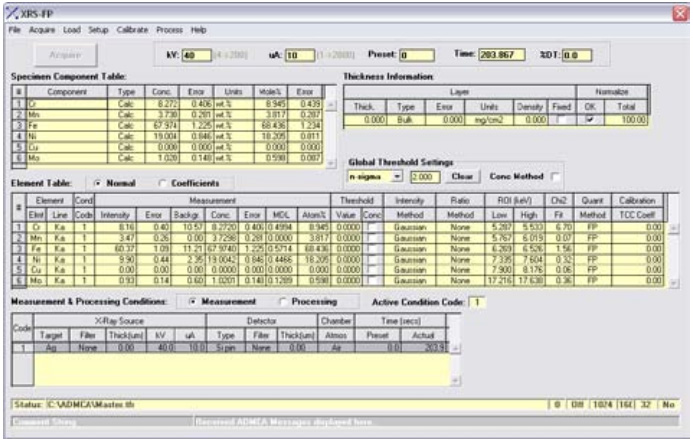
| | NIST VALUE | XRS-FP VALUE | |
| Steel316 | CR | 18.450 ± 0.05 | 18.500 ± 0.25 |
| Mn | 1.630 ± 0.01 | 1.670 ± 0.07 | |
| Fe | 65.190 ± 0.07 | 65.000 ± 0.52 | |
| Ni | 12.180 ± 0.05 | 12.270 ± 0.27 | |
| Cu | 0.169 ± 0.001 | 0.167 ± 0.026 | |
| Mo | 2.380 ± 0.01 | 2.390 ± 0.03 | |
| Steel321 | Cr | 17.400 ± 0.10 | 17.590 ± 0.23 |
| Mn | 1.800 ± 0.05 | 1.800 ± 0.07 | |
| Fe | 69.310 ± 0.15 | 68.910 ± 0.53 | |
| Ni | 11.200 ± 0.10 | 11.420 ± 0.27 | |
| Cu | 0.121 ± 0.001 | 0.119 ± 0.022 | |
| Mo | 0.165 ± 0.005 | 0.167 ± 0.009 | |
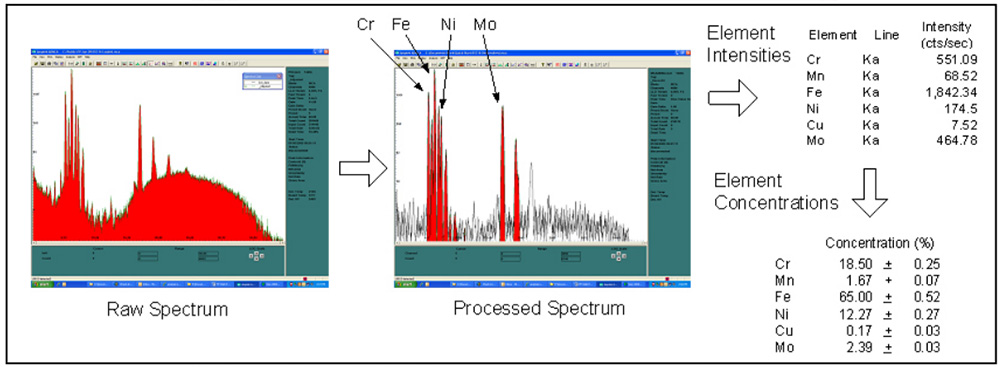
experiment conditions and to optimize processing.
XRF-FP Features
? Includes both an interactive “expert mode” and a “routine mode”. In expert mode, the user can see each step in the analysis and adjust parameters. In routine mode, after the spectrometer is set up and calibrated, one need only click a single button to acquire the data, process the spectrum, analyze the intensities, and save the output report.
handle multilayer samples up to 6 layers for simultaneous film thickness and composition analysis using FP with standards (please contact Amptek).
Second, one can choose FP with scatter ratios. This option is recommended when the sample contains a significant amount of low-Z materials, such as plastic. An estimate is made for the unanalyzed fraction of the sample by comparing the known fraction of analytes with the measured C/R ratio and ascribing the remainder to a pair of elements that bracket the estimated mean atomic number.
Several types of analysis cannot be standardless, i.e. calibration with standards (reference materials) is required.Least squares analysis cannot be standardless. If the mass thickness of the sample (i.e., the mg/cm2) is calculated, the analysis cannot be standardless.
Excitation Sources
Amptek supplies all parameters for its Mini-X X-ray tube and filter kit. If a tube from a different vendor is used, then the customer must find the critical parameters.
Radioisotopes can be used using a source file describing the relative line ratios. For secondary target excitation,monochromatic excitation is assumed.
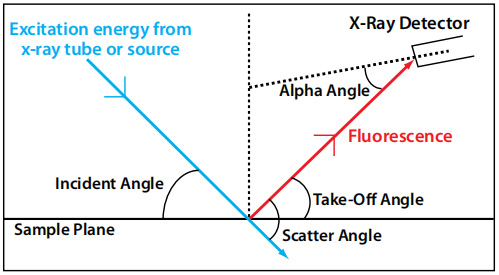
Figure 3: Geometry angle definitions.
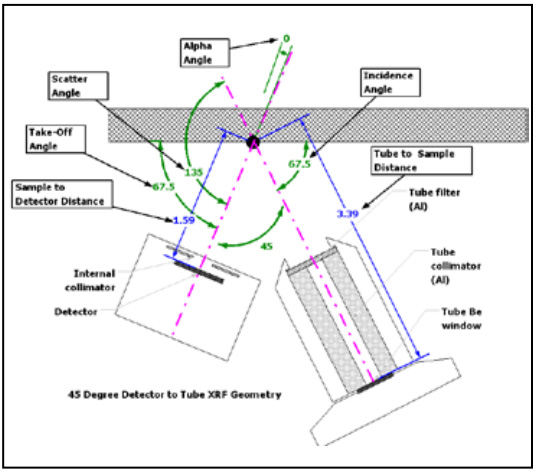
| XRF-FP Parameter | Value |
| Incidence Angle | 67.5° |
| Take-Off Angle | 67.5° |
| Alpha Angle | 0° |
| Scatter Angle | 135° |
| Tube-to-sample | 339 mm |
| Sample-to-detector | 159 mm |
Includes full corrections for absorption and both thick and thin-film secondary fluorescence. All possible lines are considered for both excitation and fluorescence. The analysis can be performed for all elements from H through Fm, using K, L or M lines in the energy range from 0.1 keV up to 60 keV.
Using known peaks in the spectrum, the software calculates the effective gain (eV/channel) and offset (zero shift) for the spectrometer. These factors are applied to subsequent spectra prior to other spectrum processing. The calibration can be specified in the XRF-FP software or in the ADMCA software. XRF-FP can automatically import the calibration from ADMCA.
 |  |
| Figure 5: Original spectrum before background removal. | Figure 6. Processed spectrum and background. The blue curve is the removed background. |
Escape Peak and Sum Peak Removal
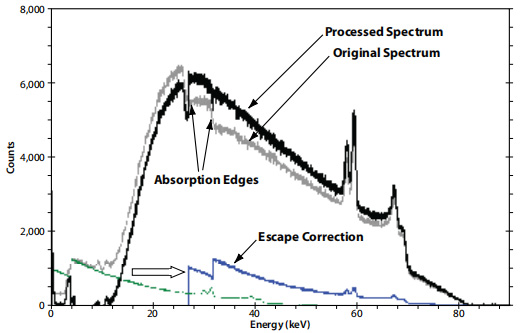
All required line energies and resolutions are calculated automatically from the specified analyte line. The Gaussian peak fitting can be done with a linear or non-linear leastsquares approach. The latter allows constrained changes in the peak positions, intra-series line ratios, and peak widths,from their nominal starting points.
In addition to calculating elemental intensities, the software automatically calculates the estimated uncertainty and background values, which allows uncertainty and Minimum Detection Limit (MDL) calculations to be performed during the FP analysis.
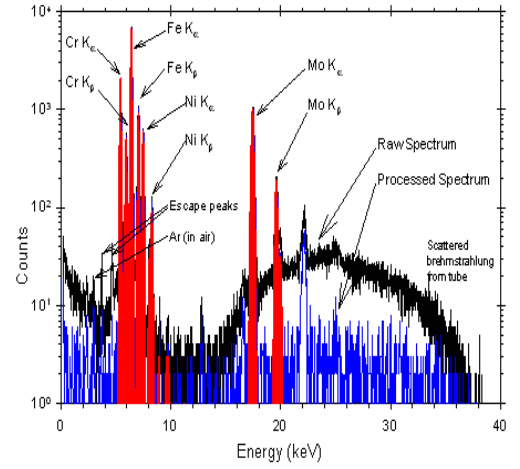

 |  |
| Experimenter’s XRF Kit with Si-PIN Includes: | Experimenter’s XRF Kit with SDD Includes: |
| ? X-123 Complete Spectrometer with Si-PIN Detector (6 mm2/500 μm, 1 mil Be window) | ? X-123 Complete Spectrometer with Super SDD (25 mm2/500 μm, 0.5 mil Be window) |
| ? Mini-X USB Controlled X-Ray Tube | ? Mini-X USB Controlled X-Ray Tube |
| ? XRF-FP Quantitative Analysis Software | ? XRF-FP Quantitative Analysis Software |
| ? MP1 XRF Mounting Plate | ? MP1 XRF Mounting Plate |
| ? Stainless Steel 316 (SS316) test sample | ? Stainless Steel 316 (SS316) test sample |
| ? Complete documentation with step-by-step instructions | ? Complete documentation with step-by-stepinstructions |
| ? XRF Kit wizard for quick software setup | ? XRF Kit wizard for quick software setup |
 微信二維碼
微信二維碼